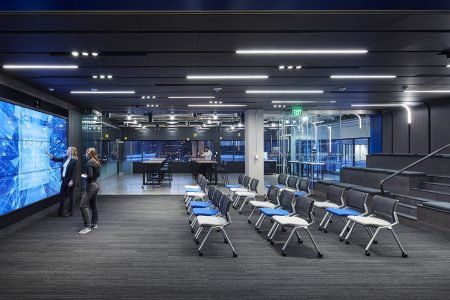Customer Experience: Emphasizing the Human in the Age of the Artificial

After all we’ve been through, could HI (Human Interaction) be the antidote for AI (Artificial Intelligence) when it comes to great customer experience? RSP’s Thom Lasley is ready to storm the barricades.
It seems pretty clear to anyone who’s been paying attention that our world has changed dramatically over the last few years. The still-smoldering pandemic, the ravages of climate change, the unsettling isolation that comes with remote working, and the tsunami of unfiltered media that sloshes into our lives every single day has left many of us dazed, confused and somewhat bewildered. And maybe longing for something that we’re not sure still exists—genuine, authentic human interaction.
Apply this dystopian mindset to the retail equation—the simple act of buying a service or product—and it’s hard to argue that things are getting better. Faster, perhaps, and maybe more convenient, but better? More enriched? Hmm, not so sure.
In our work here at RSP, we’re starting to see a shift in how we design those environments—like retail or hospitality spaces—that rely on a real, authentic and undeniable connection to the user. For those uninitiated, “user” is an architect’s word for “human.” I’m unsure when we decided to employ the language of photocopiers (maybe when we started calling homes “machines for living”), but my mission is to practice a type of design that puts the human at the center of everything.
I am not arguing that the transaction is unimportant. Or even the physical environment. On the contrary. And, yes, it’s still important that the customer feels a brand is delivering on its value proposition, but it goes beyond that. It touches on what it means to be human and the fact that we are all social animals.
There’s Revolution in the Air
The pandemic brought about unprecedented challenges for retailers but also ushered in once-in-a-lifetime opportunities to innovate through customer connections. Buying things on line and picking them up in store (BOPIS) is a great example of how we can land on small, simple solutions that solve thorny challenges. In our work for H-E-B, the Texas-based food retailer that has emerged as one of the most customer- and community-centric organizations in the country, we’ve created distinct areas that make the customer experience as well as the back-of-house and operational support a lot more friction-free. H-E-B now bakes in a BOPIS function into their design standards. And no wonder.
Pre-pandemic, around 30% of people shopped online for groceries (and even at that level, cracks in the supply chain were evident). During the pandemic, that number jumped to 80%. It’s likely these numbers will level off, of course, but the global BOPIS market is expected to reach more than $700 billion by 2027, expanding with a double-digit growth rate of 19.3% during 2021-2027. It’s a clear shift that will have a significant impact on how we design stores and commercial spaces are designed.
For Great Customer Experience, Lead with Empathy and Quality of Life
Perhaps the greatest tool a designer can draw on is a sense of empathy. Effective design research dives into people’s needs and wants and relies on careful observation, meaningful conversations and a deep understanding of the customer journey. By putting empathy and respect for how people experience the world at the heart of the design process, we can more easily identify unmet needs and bring genuine value to consumers.
Target has always been a leader in understanding the value of hyper-local design, differentiating stores with the help of regional artists, locally sourced products and flexible formats that fit the neighborhood. This makes for a far more engaging environment but it also connects in tangible ways with the customers and the community. That’s a win/win.
First, Listen. But Always Connect.
Another twist on this comes from the way retailers communicate with their customers. It’s self-evident that a retailer’s ability to listen is critical, but listening is often not as easy as it sounds. Thankfully, today’s most successful retailers are getting better at active listening, and by this I mean understanding the nature of their communication and the root meaning of what they’re saying. Retailers have long fixated on Gen Z and digital natives, but found they had to speak to a much broader base of customers who had become, out of necessity, more technologically savvy.
Thanks to a generation of digital natives, we now know how important it is to design end-to-end customer experiences that blend digital as well as molecular (i.e., brick-and-mortar) touchpoints.
Or, as a Gen Z’er would likely say, “Well Duh.”
It’s easy to have fun with the generational differences, but what if we looked at those things that aligned the generations? Those things that brought us together rather than divided us? I bet the solution is somewhere in the “human” side of the equation.
Should We Fear the Customer Experience Robot Apocalypse?
There has been a lot of ink spilled lately about Artificial Intelligence (AI) and chat bots and the unmistakable signs of an imminent, inevitable onslaught of a dystopian hellscape. But I—and I may stand alone on this—look forward to what AI means to the design world and the basis of customer experience. My sense is the deeper we dive into AI the more we will value the HI element.
For many companies, across multiple sectors, AI has become an essential component of the customer experience, especially as mobile-based messaging becomes the preferred method of communication. Chatbots are powered by some form of AI and natural language processing and are able to understand user requests and communicate via web- and mobile-based interfaces. Chatbots are designed to simulate human communication, either text-based or voice-based, and to handle common inquiries and service requests in automated fashion.
As counter-intuitive as it may sound, artificial intelligence can help sustain the human element of customer experiences, but we need to learn how to use it judiciously and effectively.
Using AI to Our Advantage
We humans are emotional, social creatures, and going through repetitive questions or concerns every day can leave us frustrated, sad and dangerously under-stimulated. On the other hand, consumers feel that customer service should be more responsive and empathetic. Automated tools like chatbots or virtual customer assistants (VCAs) provide human-like assistance that offers benefits like faster response times, on-demand and always-on customer service, and a reduced possibility of impulsive reactions like anger or frustration.
Even with artificial intelligence embedded into everyday life, humans still crave interaction with other humans. The need to talk to a person remains evident while making complex purchase decisions. Google found that 61% of mobile phone users call a business when they’re in the purchase stage of the buying cycle. This may be why BOPIS works so well—the purchase is made on-line wherever and whenever, but the social currency of shopping (i.e., the human interaction) is still there.
The convergence of AI, consumer experience and design may very well define our future world as we shift from measuring commodity transactions to enriching lives and building communities. But that means the human element will become more critical to everything we do. As designers, we need to lead the charge.






